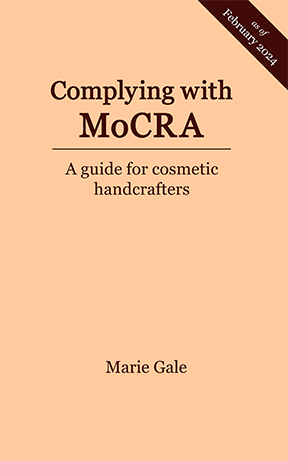MoCRA (the Modernization of Cosmetic Regulations Act of 2022) requires that cosmetic products and their ingredients have adequate safety substantiation. In other words, you must know your ingredients and your products are safe, and have some sort of scientific data to prove it.1
Following along those same lines, a cosmetic product (including the ingredients) that does not have adequate safety substantiation is an adulterated cosmetic, and prohibited from being sold.2
Adequate Safety Substantiation
“Adequate safety substantiation” means tests or studies, research, analyses, or other evidence or information that qualified experts would consider sufficient to support a reasonable certainty that the product is safe.3
MoCRA defines safe as meaning that the cosmetic product, including its ingredients, will not injure the users when the product is used in accordance with the directions on the label or in a way that is customary or usual. However, a product is not considered injurious just because it can cause minor and transient reactions or skin irritations in some users.4
Responsibility
The person or company that is named on the label of the products is the one that must ensure, and maintain records supporting, the safety of a cosmetic product.
If you make a product and your name is on the label, then you are responsible party for ensuring the product is safe and maintaining records supporting that position.
If you make a product for someone else and their name is on the label, then they are responsible for having safety substantiation.
There’s nothing stated in the law, and no regulations yet, but it’s likely that if you make private label cosmetics, your customers would expect you to have and provide them with the necessary safety documentation, if requested.
Product Testing
There are no laws or regulations that require specific tests to be performed on a cosmetic product or its ingredients. MoCRA just says it has to be documented, not where the documentation comes from. The FDA says that it can be sufficient to have documentation showing that the ingredients are safe and the formulation is similar to other products which have been proven safe.
One of the biggest threats to the safety of cosmetic products is microbial contamination. An adequate preservative system is the best way to combat microbial contamination. The best way to verify that a preservative system is working is to have the product tested. However, when you have a preservative system in place, it may be sufficient to have have documentation that the preservative is safe and that it is being correctly and effectively used, along with records showing you have eliminated the most likely potential sources of microbial contamination.
Having good manufacturing practices in place the best way to ensure that your products are not adulterated by microbial contamination or in some other way.
Existing Safety Data
You can use relevant safety data that is already available for your ingredients or for similar formulations. Keep in mind, however, that all data used to support the safety must come from scientifically robust methods.
The following resources may provide documentation to support the safety and/or safe usage levels of the ingredients you use:
– Manufacturer or supplier documentation
The manufacturer of your ingredient may have safety substantiation that they can provide. What you would need depends on the type of ingredient.
Color additives. Get a Certificate of Analysis which shows that the color additive meets any regulatory specifications for the color.
Fragrance oils (where the components don’t have to be disclosed). Get a Certificate of Conformity of Fragrance Mixtures with IFRA Standards which will tell you the safe levels to use.
Blended ingredients. For synthetic or blended ingredients, trademarked or patented items, or preservatives, get at least the names of the components (since they must be listed individually in the ingredient declaration). Your supplier may also be able to provide actual safety studies.
Over time it is likely that more suppliers (especially those who provide ingredients to handcrafters and very small businesses) will see the importance of providing this information to their customers, in order to keep them as customers!
– Cosmetic Ingredient Review Expert Panel (CIR)
The CIR is a review panel under the Personal Care Products Council which reviews cosmetic ingredient safety data. They have published hundreds of reports over the past 30 years covering many commonly used cosmetic ingredients.
https://www.cir-safety.org/ingredients
– International Fragrance Association (IFRA)
IFRA publishes documentation on the safety of fragrance ingredients. The Complete IFRA Standards includes information on the safe maximum usage levels for various fragrance components (including components in essential oils) in different types of products. Documentation that the fragrances in your cosmetic product are within the IFRA maximum usage rates is a form of safety substantiation.
IFRA has also compiled a list of sources (particularly plants) that contain components that are prohibited or restricted under the IFRA standards along with the concentration of each component in the plant. It is the Annex on Contributions from Other Sources. It is very handy for determining if your use of botanical ingredients is safe.
Both documents can be found at https://ifrafragrance.org/safe-use/standards-documentation
– Color additives approved for use in cosmetics (US)
In the United States, the only color additives that are permitted in cosmetics are those that have been approved by the FDA for use in cosmetics. The color additives may only be used in the way for which they were approved (some have limitations or restrictions).
Documentation that the color additives you are using are approved by the FDA, and that you are using them in the way for which they were approved, can substantiate your safe use of color additives. The list of approved color additives is available on the FDA website.
– EU cosmetic regulations
The cosmetic regulations for the European Union (EU) include several Annexes which list prohibited ingredients, restricted ingredients, allowed color additives, and allowed preservatives based on the safety standards of the EU. While these are not legally applicable in the US, they give information about safe usage.
The full content of EC 11223/2009 Cosmetic Regulation (as of Jan 13, 2024), with all the Annexes, is available online.
Annex III – Restricted Ingredients
Annex III lists 371 ingredients that are currently restricted for use in cosmetics in some way.
Many of the restricted ingredients are dyes used in hair color and unlikely to be used in handcrafted or small business cosmetics. About 50 are ingredients or components of ingredients that are not actually restricted or limited, but must be declared as fragrance allergens if present at 0.01% (rinse-off products) or 0.001% (leave-on products). 5
The remainder are actually restricted for some safety reason. If an ingredient in your product is on the restricted list for the EU, documentation showing that you are using it within the restrictions set forth is a form of safety substantiation.
Annex IV – Color Additives
Important note: The list of color additives approved for use in the EU is NOT applicable for cosmetics sold in the United States. Only use the list of color additives approved for use in the United States.
Annex V – Preservatives
Annex V lists 60 preservatives that have restrictions, limitations, and maximum usage amounts. If your usage is within the recommended levels, it could be helpful in documenting the safety of your product.
– PubMed®
The National Library of Medicine maintains PubMed, which comprises more than 36 miillion citations for biomedical literature from MEDLINE, life science journals, and online books. Citations may include links to full text content, although some publications and articles may have a fee for viewing the full text.
PubMed is a good place for a deep dive into the safety of your cosmetic ingredients. Be prepared for complex medical and scientific jargon. https://pubmed.ncbi.nlm.nih.gov/
– Google Scholar
Google Scholar is an arm of Google which searches the full text or metadata of scholarly literature. It is a good source for locating articles about the safety of specific ingredients. As with most Google searching, the terms used in the search will determine the success of the search. Adding “cosmetic” and/or “safety” to the search term may help limit the number of returns to a reasonable amount. The search results may lead you to the full text of the article or publication, however some results may require registration and/or a fee to view the full content.
https://scholar.google.com/
In Summary
It’s surprising that knowing that your cosmetic ingredients and your final product are safe it wasn’t part of the law in the US, but now, thanks to MoCRA, it is. There are many resources for substantiation that your products and ingredients are safe. Having the information on file is good for both for your peace of mind and for your legal compliance.
If tracking down safety substantiation information for your ingredients and products seems daunting, I can assist — it’s one of the (many) things I can do as part of my consulting services.

Shameless plug!
To find out how MoCRA applies to you, what you need to do, and when you need to do it by, get my book from Amazon and use it.
Up to date as of May 2024.



Leave a Reply